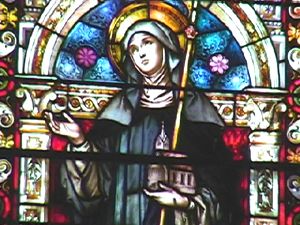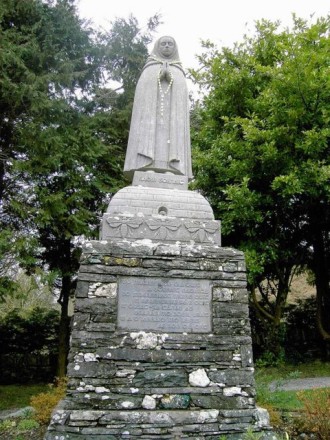
Summary: St Gobnait is one of Co. West Cork’s best loved saints but only traditions surrounding her life survive today.

Patrick Duffy summarises what the traditions tell us about her.
<The image (left) shows a detail of the St Gobnait window by Harry Clarke in the Honan University Chapel at University College, Cork.
Local traditions connect Gobnait with bees, with Ballyvourney, Co Cork and with her care for the sick. It is a happy coincidence that her feast is on World Day of the Sick, 11th February, the day Our Lady appeared to Bernadette at Lourdes.
Early Life
Gobnait is said to have been born in Co Clare. In her youth she went to the Aran Islands to study monastic life with St Enda. There is a church dedicated to her, Kilgobnet, on Inisheer. An angel told her that this was not to be the place of “her resurrection” (death) and that she should tour Ireland until she found a place where she found nine white deer grazing. On her travels she is said to have founded churches at Dunquin in Co Kerry and Dungarvan in Co Waterford.
 Ballyvourney and Bees
Ballyvourney and Bees
But it was at Ballyvourney, Co Cork, that she eventually ‘found‘ the nine white deer grazing. Here she founded a monastery with the help of St Abban. Famous among the miracles of Gobnait’s prayer was the stopping of a pestilence by marking off the parish as consecrated ground. She is also famed for her cultivation of bees and a story relates how she routed an enemy by loosing her bees upon them. Tradition indicates that Gobnait could comunicate with the bees
Patron of Ironworkers
“That Gobnait herself was originally a patron of ironworkers is indicated by the implications of her name, which is based on the hypocoristic (=pet-name) Gobba, from ‘gabha’ or ‘smith‘. Excavation at her church in Ballyvourney yielded considerable evidence of ironworking on the site” (Pádraig Ó Riain, A Dictionary of Irish Saints (2011).
Care of the Sick
Gobnait is remembered for her care of the sick. In the church yard at Ballyvourney many discarded crutches show that people believed they were cured by Gobnait answering their prayers. Her well is still at Ballyvourney and is an attraction for pilgrims.
Associations
There is a tradition that in 1602, when after the defeat at Kinsale and the destruction of his castle at Dunboy, Donal Cam O’Sullivan Beara was retreating with his soldiers – along with their women, children and servants – to the territory of O’Rourke of Breifne, they stopped at Ballyvourney to pay homage to the memory of Gobnait.
Until 1843 a 13th century wooden statue of the saint was in the hereditary keeping of the O’Herlihy family there. The tradition is that it was the O’Herlihy family who gave her the land to build her convent. After 1600 years blessed ribbons of St Gobnait are still distributed on her feastday.